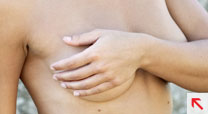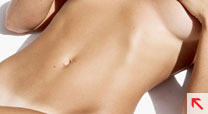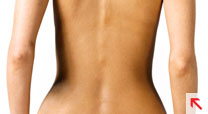Breast Reduction
Women with very large, pendulous breasts may experience a variety of medical problems caused by the excessive
weight-from back and neck pain and skin irritation to skeletal deformities and breathing problems. Bra straps
may leave indentations in their shoulders. And unusually large breasts can make a woman-or a teenage girl-feel
extremely self-conscious.
Breast reduction, technically known as reduction mammaplasty, is designed for such women. The procedure removes
fat, glandular tissue, and skin from the breasts, making them smaller, lighter, and firmer. It can also reduce the
size of the areola, the darker skin surrounding the nipple. The goal is to give the woman smaller, better-shaped
breasts in proportion with the rest of her body.
The Best Candidates For Breast Reduction
Breast reduction is usually performed for physical relief rather than simply cosmetic improvement. Most women who
have the surgery are troubled by very large, sagging breasts that restrict their activities and cause them physical
discomfort.
In most cases, breast reduction isn't performed until a woman's breasts are fully developed; however, it can be done
earlier if large breasts are causing serious physical discomfort. The best candidates are those who are mature enough
to fully understand the procedure and have realistic expectations about the results. Breast reduction is not recommended
for women who intend to breast-feed.
All Surgery Carries Some Uncertainty and Risk
Breast reduction is not a simple operation, but it's normally safe when performed by a qualified plastic surgeon.
Nevertheless, as with any surgery, there is always a possibility of complications, including bleeding, infection, or
reaction to the anesthesia. Some patients develop small sores around their nipples after surgery; these can be treated
with antibiotic creams.
The procedure does leave noticeable, permanent scars, although they'll be covered by your bra or bathing suit. (Poor
healing and wider scars are more common in smokers.) The procedure can also leave you with slightly mismatched breasts
or unevenly positioned nipples. Future breast-feeding may not be possible, since the surgery removes many of the milk
ducts leading to the nipples.
Some patients may experience a permanent loss of feeling in their nipples or breasts. Rarely, the nipple and areola may
lose their blood supply and the tissue will die. (The nipple and areola can usually be rebuilt, however, using skin grafts
from elsewhere on the body.)
Where Your Surgery Will Be Performed
Breast reduction surgery may be performed in a hospital, an outpatient surgery center or an office-based surgical suite.
If you are admitted to the hospital, your stay will be a short one. The surgery itself usually takes two to four hours, but
may take longer in some cases.
Type of Anesthesia
Breast reduction is nearly always performed under general anesthesia. You'll be asleep through the entire operation.
The Surgery
Techniques for breast reduction vary, but the most common procedure involves an anchor-shaped incision that circles the
areola, extends downward, and follows the natural curve of the crease beneath the breast. The surgeon removes excess glandular
tissue, fat, and skin, and moves the nipple and areola into their new position. He then brings the skin from both sides of
the breast down and around the areola, shaping the new contour of the breast. Liposuction may be used to remove excess fat
from the armpit area.
In most cases, the nipples remain attached to their blood vessels and nerves. However, if the breasts are very large or
pendulous, the nipples and areolas may have to be completely removed and grafted into a higher position. (This will result
in a loss of sensation in the nipple and areolar tissue.)
Stitches are usually located around the areola, in a vertical line extending downward, and along the lower crease of the
breast. In some cases, techniques can be used that eliminate the vertical part of the scar. And occasionally, when only fat
needs to be removed, liposuction alone can be used to reduce breast size, leaving minimal scars.
After Your Surgery
After surgery, you'll be wrapped in an elastic bandage or a surgical bra over gauze dressings. A small tube may be placed
in each breast to drain off blood and fluids for the first day or two.
You may feel some pain for the first couple of days-especially when you move around or cough-and some discomfort for a week
or more.The bandages will be removed a day or two after surgery, though you'll continue wearing the surgical bra around the
clock for several weeks, until the swelling and bruising subside. Your stitches will be removed in one to three weeks.
Your first menstruation following surgery may cause your breasts to swell and hurt. You may also experience random, shooting
pains for a few months. You can expect some loss of feeling in your nipples and breast skin, caused by the swelling after surgery.
This usually fades over the next six weeks or so. In some patients, however, it may last a year or more, and occasionally it may
be permanent.
Getting Back to Normal
Although you may be up and about in a day or two, your breasts may still ache occasionally for a couple of weeks. You should
avoid lifting or pushing anything heavy for three or four weeks.
Most women can return to work (if it's not too strenuous) and social activities in about two weeks.
Although much of the swelling and bruising will disappear in the first few weeks, it may be six months to a year before your
breasts settle into their new shape. Even then, their shape may fluctuate in response to your hormonal shifts, weight changes,
and pregnancy.
The Most Common Procedures We Perform:









